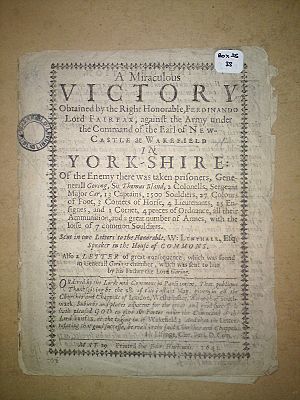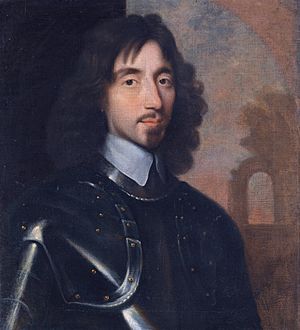Capture of Wakefield facts for kids
Quick facts for kids Capture of Wakefield |
|||||||
|---|---|---|---|---|---|---|---|
| Part of the First English Civil War | |||||||
 A Miraculous Victory obtained by the Right Honorable Ferdinando Lord Fairfax at Wakefield; pamphlet published in London on 27 May 1643 |
|||||||
|
|||||||
| Belligerents | |||||||
| Royalists | Parliamentarians | ||||||
| Commanders and leaders | |||||||
| George Goring (POW) | Sir Thomas Fairfax | ||||||
| Strength | |||||||
| c. 3,000 | c. 1,500 | ||||||
The capture of Wakefield was an important battle during the First English Civil War. It happened on May 21, 1643, in Wakefield, Yorkshire. A group of soldiers loyal to Parliament (called Parliamentarians) attacked the town. Wakefield was held by soldiers loyal to King Charles I (called Royalists).
The Parliamentarian force was led by Sir Thomas Fairfax. He had about 1,500 men. The Royalist soldiers in Wakefield were led by George Goring. They had about 3,000 men, so they greatly outnumbered Fairfax's troops.
Even though they were outnumbered, the Parliamentarians successfully stormed the town. They fought for about two hours in the early morning. Fairfax's men captured around 1,400 Royalist prisoners. This was a big win for Parliament.
Fairfax had a special reason for attacking Wakefield. Earlier, about 800 of his men were captured at the Battle of Seacroft Moor. He wanted to capture Royalist soldiers to trade them for his own men. This was called a prisoner exchange. Fairfax got the prisoners he needed and also a lot of ammunition. He reported that his side lost only about seven men.
Contents
What Caused the English Civil War?
The English Civil War began in August 1642. It was a fight between King Charles I and Parliament. They disagreed about how England should be ruled. The King believed he had a divine right to rule. Parliament wanted more power and control.
These disagreements had been building for over 50 years. They involved arguments about religion, money, and laws. When the King tried to arrest five members of Parliament in January 1642, things got worse. People started choosing sides.
Yorkshire became a very important area in this war. Many important events happened there. The King even set up his base in York for a time.
Early Battles in Yorkshire
Before the Wakefield battle, the King's army had an advantage in Yorkshire. They had about 6,000 soldiers. Parliament's main army had less than 1,000 men. This forced Parliament's soldiers to retreat.
However, Sir Thomas Fairfax, who was a Parliamentarian leader, had a big success. In January 1643, he successfully attacked and took Leeds. This helped Parliament regain control of the West Riding of Yorkshire. They set up strong bases in Bradford and Leeds.
Planning the Attack on Wakefield
Sir Thomas Fairfax had a personal reason for attacking Wakefield. He had lost 800 of his men at the Battle of Seacroft Moor in March 1643. These men were captured by Royalist forces led by George Goring. Families of the captured soldiers put pressure on Fairfax. He planned to surprise Wakefield to capture enough Royalist soldiers to trade for his own men.
Fairfax thought Wakefield was held by only about 900 Royalist soldiers. But the Royalist commander, the Earl of Newcastle, had placed Goring and about 3,000 men in Wakefield. This was to protect against Parliamentarian forces in Leeds.
On May 20, the day before the attack, Goring and other Royalist officers were at a party. They were guests at Heath Hall, just outside Wakefield. They were playing games and having a good time. Some historians suggest they were not paying enough attention to the town's defenses that night.
The Battle of Wakefield
On the evening of May 20, 1643, Parliamentarian soldiers gathered. They came from Bradford, Leeds, and Halifax. They met at Howley Hall at midnight. With more troops from Howley Hall, Fairfax's army had about 1,500 men. This included 1,000 infantry (foot soldiers) and 500 horsemen (cavalry and dragoons).
Sir Thomas Fairfax was in charge of the whole force. His cousin, William Fairfax, and George Gifford led the infantry. At 2 AM, the Parliamentarians surprised a small Royalist outpost near Stanley. This was about 2.5 miles from Wakefield.
Attacking the Town
Fairfax's army reached Wakefield around two hours later, just before dawn. Wakefield was not a strong, walled town. Its defenses were mainly hedges around properties and barricades in the streets. The hedges provided some protection. The barricades became the main focus of the fighting.
The Royalist defenders had been warned by their cavalry who escaped from Stanley. They had placed 500 to 800 musketeers in the hedges. They also sent out a cavalry unit. Parliamentarian foot soldiers pushed back the musketeers. Their larger cavalry force drove the Royalist horsemen back into Wakefield.
Fairfax soon realized the Royalist army was much bigger than he expected. There were about 3,000 Royalists, three times what he thought. But after a quick meeting with his commanders, Fairfax decided to continue the attack.

Fairfax split his army to attack from two sides. Sir Henry Foulis and William Fairfax attacked Northgate. Thomas Fairfax and Gifford attacked Warrengate, the eastern entrance. After about two hours of fighting, Gifford's foot soldiers broke through Warrengate. They captured a cannon and used it against the barricade. This cleared the way for the cavalry. Thomas Fairfax then led three groups of cavalry into the town. They quickly defeated the Royalist foot soldiers along Warrengate.
Goring's Capture and Royalist Defeat
George Goring, the Royalist commander, was reportedly ill in bed. Some accounts say he had a fever. Others suggest he was feeling unwell from the previous day's party. Despite this, he led a counterattack on horseback. He was captured by Lieutenant Alrud. Goring's father and his second-in-command managed to escape.
Fairfax continued to push the attack. He almost got captured himself when he became separated from his men. He was holding two prisoners. A Royalist officer saw him but asked one of Fairfax's prisoners for orders. The prisoner stayed silent. Fairfax quickly left his prisoners and escaped back to his men.
Gifford moved the captured cannon to the churchyard of All Saints Church (now Wakefield Cathedral). He aimed it at the Royalists in the marketplace. After they refused to surrender, his musketeers and the cannon opened fire. Then, the cavalry charged. The remaining Royalist soldiers either ran away or gave up. By 9 AM, the Parliamentarians controlled the town.
They captured about 1,400 prisoners, including Goring. They also took 28 Royalist flags (called colours) and a lot of needed ammunition. Fairfax reported that his force lost "not above seven men." He did say that "many of our men were shot and wounded."
What Happened Next
After their victory, the Parliamentarians published many pamphlets. They said their win was "the work of God." They also described the Royalists as dishonest. Parliament declared May 28 a day of thanksgiving for the victory.
Fairfax knew that a larger Royalist army was nearby. So, he quickly retreated back to Leeds with his prisoners. Instead of attacking, the Royalist commander, Newcastle, pulled his own forces back to York.
Goring was sent to the Tower of London as a prisoner. The Royalists tried to get him exchanged right away. But he stayed in prison for over a year. He was finally exchanged in April 1644 for another important prisoner.
The main goal of the attack was successful. Fairfax got his men back who were captured at Seacroft Moor. The victory also briefly changed the balance of power in Yorkshire. However, this advantage did not last long. Just over a month later, Fairfax's army was defeated at the Battle of Adwalton Moor. This gave the Royalists control of most of Yorkshire again.
By the end of 1644, Parliamentarian forces had captured most of northern England. This was helped by Fairfax's big win at the Battle of Marston Moor. The next year, Fairfax became the commander-in-chief of Parliament's forces. He created the "New Model Army". This army won many battles, like Naseby. These wins helped Parliament gain control of most of England.
Near Wakefield, Sandal Castle had remained a Royalist stronghold. The castle was old and damaged. But it had been strengthened with earthworks. Parliamentarian forces attacked the castle twice in 1645. It finally surrendered in October. After that, the castle was partly destroyed so it could not be used again. In May 1646, King Charles I surrendered. This ended the First English Civil War.
Images for kids
-
A Miraculous Victory obtained by the Right Honorable Ferdinando Lord Fairfax at Wakefield; pamphlet published in London on 27 May 1643



